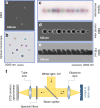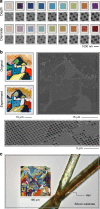Dielectric Mie voids: confining light in air
- PMID: 36587036
- PMCID: PMC9805462
- DOI: 10.1038/s41377-022-01015-z
Dielectric Mie voids: confining light in air
Abstract
Manipulating light on the nanoscale has become a central challenge in metadevices, resonant surfaces, nanoscale optical sensors, and many more, and it is largely based on resonant light confinement in dispersive and lossy metals and dielectrics. Here, we experimentally implement a novel strategy for dielectric nanophotonics: Resonant subwavelength localized confinement of light in air. We demonstrate that voids created in high-index dielectric host materials support localized resonant modes with exceptional optical properties. Due to the confinement in air, the modes do not suffer from the loss and dispersion of the dielectric host medium. We experimentally realize these resonant Mie voids by focused ion beam milling into bulk silicon wafers and experimentally demonstrate resonant light confinement down to the UV spectral range at 265 nm (4.68 eV). Furthermore, we utilize the bright, intense, and naturalistic colours for nanoscale colour printing. Mie voids will thus push the operation of functional high-index metasurfaces into the blue and UV spectral range. The combination of resonant dielectric Mie voids with dielectric nanoparticles will more than double the parameter space for the future design of metasurfaces and other micro- and nanoscale optical elements. In particular, this extension will enable novel antenna and structure designs which benefit from the full access to the modal field inside the void as well as the nearly free choice of the high-index material for novel sensing and active manipulation strategies.
© 2023. The Author(s).
Conflict of interest statement
The authors declare no competing interests.
Figures





References
Grants and funding
- RiSC Project "Mie Voids/Ministerium für Wissenschaft, Forschung und Kunst Baden-Württemberg (Ministry of Science, Research and Art Baden-Württemberg)
- ERC Advanced Grant Complexplas/EC | EU Framework Programme for Research and Innovation H2020 | H2020 Priority Excellent Science | H2020 European Research Council (H2020 Excellent Science - European Research Council)
- ComplexPlas/EC | EU Framework Programme for Research and Innovation H2020 | H2020 Priority Excellent Science | H2020 European Research Council (H2020 Excellent Science - European Research Council)
- ComplexPlas/EC | EU Framework Programme for Research and Innovation H2020 | H2020 Priority Excellent Science | H2020 European Research Council (H2020 Excellent Science - European Research Council)
- SPP1839 Tailored Disorder/Deutsche Forschungsgemeinschaft (German Research Foundation)
LinkOut - more resources
Full Text Sources

